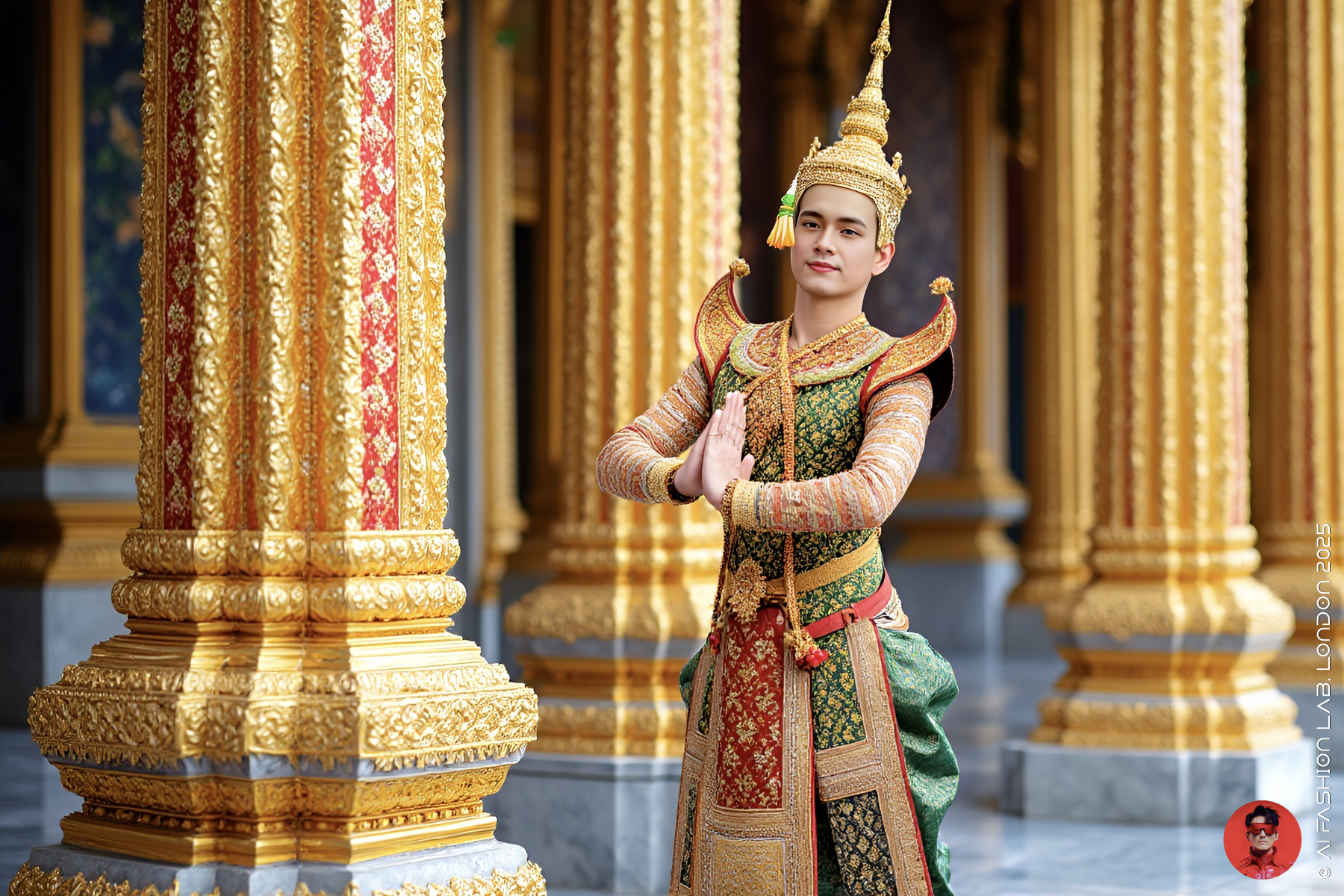กระบวนการการสร้างสรรค์ภาพนาฏศิลป์ไทยด้วย AI
กระบวนการการสร้างสรรค์ภาพนาฏศิลป์ไทยด้วย AI
ในช่วงตั้งแต่หลังกลางปีที่ผ่านมา ผมได้เปลี่ยนกระบวนการสร้างสรรค์ภาพด้วยเอไอ จากการใช้ text-to-image หรือ image-to-image มาเป็นการฝึกโมเดล LoRA เพื่อสร้างสรรค์ภาพประวัติศาสตร์แฟชั่นไทยโดยเฉพาะ โดยไม่ต้องพึ่ง AI ระบบศูนย์กลางซึ่งตัวโมเดลพื้นฐานถูกฝึกด้วพภาพจากวัฒนธรรมตะวันตกเป็นส่วนใหญ่ การฝึกโมเดล LoRA กับระบบ AI แบบ open source นั้นมีข้อดีที่เราสามารถใช้ฐานข้อมูลที่เราจัดเตรียมมาเอง และภาพที่ใช้ถูกต้องกับบริบททางวัฒนธรรมของไทย และการฝึกโมเดล LoRA เองนั้นก็เป็นการทดลองใช้ AI เพื่อช่วยในการอนุรักษ์และสร้างสรรค์ภาพของแฟชั่นและเครื่องแต่งกายของไทยตั้งแต่การเริ่มต้นมีการถ่ายภาพในสมัยรัชกาลที่ 3 เป็นต้นมา
และเมื่อไม่นานมานี้ผมได้ลองฝึกโมเดล AI ให้สร้างสรรค์ ละครรำไทย โดยเฉพาะอย่างยิ่งบท ตัวพระ หนึ่งในข้อจำกัดที่แก้ไขยากที่สุดของการสร้างภาพจากการเทรน LoRA ที่ผมพบก็คือ การจัดท่ามือของมนุษย์ — โดยเฉพาะท่ามือที่มีความหมายในเชิงวัฒนธรรมและมีแบบแผน
ท่ารำไทย เช่น การจีบ และ การตั้งวงนั้น ต่างจากท่าทางทั่วไปในชีวิตประจำวัน ซึ่งต้องอาศัยความแม่นยำของการรำด้วยการจัดนิ้วมือ การบิดข้อมือ และจังหวะของร่างกายที่เชื่อมต่อกันทั้งหมด ซึ่งโมเดล AI ส่วนใหญ่ (ซึ่งถูกฝึกด้วยภาพจากโลกตะวันตกเป็นหลัก) ไม่สามารถเข้าใจหรือถ่ายทอดได้อย่างถูกต้อง
เพื่อเอาชนะข้อจำกัดนี้ ผมจึงได้ฝึกโมเดล LoRA ขึ้นมาเอง โดยเน้นที่ภาพของ ละครรำตัวพระ และพยายามให้ AI เข้าใจทั้งรูปทรงท่าทางและรายละเอียดเครื่องแต่งกายของละครรำไทย ซึ่งพบว่ามีความยากและท้าทายอย่างมาก โดยเฉพาะ ท่าจีบ และ การตั้งวง ที่ต้องใช้การจัดท่ามือที่ละเอียดอ่อน
ข้อสังเกตและประสบการณ์จากการทดลอง
🔸 ท่ารำ
แม้จะใช้ LoRA หรือ ControlNet โมเดลก็ยังมีปัญหากับท่าทางของนิ้วมือและข้อมือ โดยเฉพาะท่าที่มีความเป็น “รหัสทางวัฒนธรรม” เช่นใน โขน หรือ ละครรำ
ในบท ตัวพระ ท่ารำหลายท่าขึ้นอยู่กับ “การเปลี่ยนท่าที่มีจังหวะและการหยุดนิ่งเฉพาะจุด” ซึ่ง AI ยังไม่เข้าใจ — เว้นแต่จะมีการฝึกด้วยข้อมูลลำดับภาพเคลื่อนไหวหรือการจับท่าทางที่ต่อเนื่อง
แนวทางแก้ไข: การใช้เครื่องมือ annotation อย่าง OpenPose หรือ MediaPipe มาช่วยกำหนดจุดของมือและข้อมือในภาพชุดฝึก จะช่วยให้โมเดลเข้าใจโครงสร้างมือดีขึ้น แม้อาจยังไม่สมบูรณ์แบบ แต่จะช่วยให้ AI สร้างท่าทางได้ใกล้เคียงขึ้น
🔸 รายละเอียดลวดลายและเครื่องแต่งกาย
AI มักจะทำให้รายละเอียดปักดิ้นทองหรือลายผ้าเนียนกลืนไปกับเนื้อผ้า โดยเฉพาะเมื่อมีความซับซ้อนหรือความต่างของสีต่ำ รายละเอียดของรายละเอียดการปักและยกดอ้น มักไม่ชัดเจน
แนวทางแก้ไข: การแยกกระบวนการสร้างภาพเป็น 2 ขั้นตอน เช่น ให้ AI สร้างโครงท่า (pose/form) ก่อน แล้วค่อยเพิ่มชั้นของรายละเอียดเครื่องแต่งกาย หรือใช้ LoRA แยกกันสำหรับท่าร่างกายและลวดลายผ้าก็เป็นวิธีที่น่าสนใจ จริงๆผมใช้ LoRA 3 โมเดล โมเดลแรกคือการสร้างตัวละคร ตัวพระ โมเดลที่ 2 ท่ารำและมือโดยเฉพาะ โมเดลที่ 3 รายละเอียดของเครื่องแต่งกาย
โครงการอื่น ๆ ที่เกี่ยวข้องกับ AI และนาฏศิลป์ไทย
ในช่วงไม่กี่ปีที่ผ่านมา มีโครงการด้าน AI ที่เกี่ยวข้องกับนาฏศิลป์ไทยโดยเฉพาะ เช่น โครงการ Cyber Subin โดย MIT Media Lab ร่วมกับศิลปินร่วมสมัยชาวไทย พิเชษฐ กลั่นชื่น ซึ่งเน้น “การแสดงร่วมกันระหว่างมนุษย์กับ AI” (Human–AI Co-dancing) Cyber Subin ใช้ท่ารำพื้นฐานในระบบ แม่บทใหญ่ ของรำไทย มาเป็นจุดเริ่มต้นในการสร้างสรรค์ท่าทางใหม่ในเชิงทดลองและร่วมสมัย ผู้รำสามารถสั่งการให้ AI ขยับท่าทางผ่านเสียงได้ในแบบเรียลไทม์ โครงการนี้จึงเน้นที่ การแสดงและการออกแบบท่าเต้นแบบใหม่ มากกว่าการรักษาขนบแบบเดิม
และมี โมเดล AI ตัวใหม่ของ Google Imagen 3 ที่สามารถสร้างภาพโขนได้ค่อนข้างดี
ทำไมเรื่องนี้จึงสำคัญ
จากประสบการณ์นี้ ผมเห็นชัดเจนมากขึ้นว่าเราต้องการ โมเดล AI ที่ออกแบบมาเฉพาะสำหรับวัฒนธรรมเอเชียหรือเอเชียตะวันออกเฉียงใต้ เพราะระบบ AI ปัจจุบันส่วนใหญ่ใช้ข้อมูลจากโลกตะวันตกเป็นฐาน ซึ่งทำให้ศิลปะ ความงาม และรูปแบบของโลกตะวันออกถูกลดทอนหรือแทบไม่มีตัวตนในโลก AI
Visualising Thai Classical Dance with AI
In my recent creative work, I’ve been exploring how AI can be used to represent and preserve Thai classical dance — specifically Lakhon Ram and the stylised male role known as tua phra. One of the biggest limitations I’ve encountered in AI image generation is its consistent struggle with human hand gestures, especially those that are culturally codified and symbolic.
Unlike natural body movement, traditional Thai dance gestures such as jeeb (จีบ) and tang wong (ตั้งวง) require precise finger articulation, wrist positioning, and rhythmic tension that AI models — most of which are trained on Western-centric datasets — simply don’t understand.
To overcome this, I’ve been training my own LoRA models specifically on Thai classical dance imagery, focusing on these intricate and culturally meaningful poses. The process has been difficult, especially when trying to preserve both the gesture clarity and the ornate costume details unique to Thai performing arts.
A few thoughts and observations from this process:
🔸 Hand Gestures
LoRA and ControlNet models still struggle with fine motor precision — particularly when it comes to stylised symbolic gestures like those in Khon or Lakhon Nai.
In tua phra, many poses depend not just on static positioning, but on specific transitions and rhythmic stops, something AI doesn’t yet understand unless trained on motion or pose sequences — which may require video data or tracking tools, not just still images.
Possible solution: Combining pose annotation tools like OpenPose or MediaPipe with your training set can help reinforce hand and wrist structure. It won’t make the gestures perfect, but it gives the model a better sense of shape and flow.
🔸 Embroidery & Costume Details
AI tends to smooth out intricate embroidery, especially when metallic threads or low-contrast textures are involved. Thai classical costumes — full of gold brocade, appliqué, and ornate symmetry — often get lost or blended.
Possible solution: Multi-stage image generation might help — first generating the base pose or body form, then overlaying high-resolution textiles or costume-specific LoRA layers. Some researchers have even trained two LoRA models separately — one for anatomy/pose, one for costume texture.
Context: Other AI Projects in Thai Dance
There have been AI projects focused on Thai classical dance — especially in education or research settings. These are often motion-capture-based, using tools to record and simulate movements in 3D. Most are not image-generation projects, and very few are based on LoRA.
One well-known example is Cyber Subin, a project by MIT Media Lab and Thai choreographer Pichet Klunchun. This project focuses on choreography and performance using AI — where dancers interact with voice-controlled virtual agents that reimagine Thai movement principles in real-time.
Cyber Subin draws from Thai classical vocabulary (Mae Bot Yai) but uses it as a jumping-off point for contemporary, interpretive work, not strict preservation.
In contrast, my project is about holding on to the traditional form, and exploring how AI can generate visual referencesfor gestures, costumes, and staging that align more closely with classical standards.
Why It Matters
This experience has made it increasingly clear to me that we need AI models dedicated to Asia or Southeast Asia’s cultural heritage. Most mainstream AI platforms default to Western norms — not just in body language, but in fashion, architecture, posture, and visual rhythm. There’s a rich world of intangible heritage that deserves better representation.
What I’m doing isn’t perfect. But it’s a step toward building a visual vocabulary — one frame at a time — that honours our heritage in the digital age.
#aifashionlab #AI #aiartist #aiart #aifashion #aifashiondesign #aifashionstyling #aifashiondesigner #fashion #fashionhistory #historyoffashion #fashionstyling #fashionphotography #digitalfashion #digitalfashiondesign #digitalcostumedesign #digitaldesign #digitalaiart #ThaiFashionHistory #ThaiFashionAI #flux #kreaflux #kreatraining








































